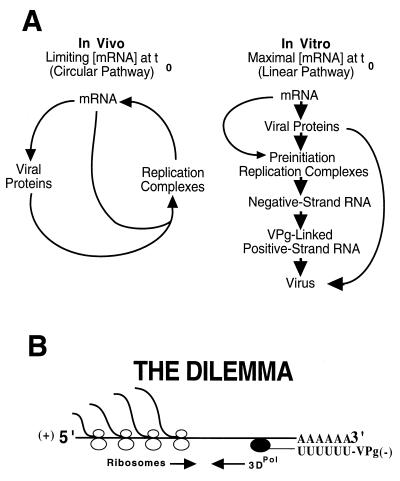FIG. 1.
Pathways of poliovirus replication and the dilemma of ribosome-polymerase collisions. (A) The replication of poliovirus RNA in infected cells and in cell-free replication reactions in vitro is fundamentally different. The initial concentration of viral RNA in the cytoplasm of infected cells is very low. In the infected cell, protein synthesis and RNA replication are codependent since protein synthesis requires RNA replication and vice versa. During the course of the infection, this results in the amplification of the input viral RNA and leads to a circular replication pathway. In contrast, a relatively high concentration of input virion RNA is used in the in vitro reactions to achieve maximum rates of protein synthesis. In this case, amplification of the input RNA is not required to achieve maximum rates of protein synthesis and RNA replication in vitro, which leads to a linear replication pathway. (B) Poliovirus RNA is translated before it replicates (30). Translating ribosomes move 5′ to 3′ on the viral mRNA, while the poliovirus polymerase must initiate negative-strand RNA synthesis at the 3′ terminus of the viral RNA and move in a 3′-to-5′ direction. The results of this study indicate that the poliovirus polymerase is not able to dislodge translating ribosomes from viral mRNA. This suggests that the virus has evolved a different mechanism to regulate the switch from translation to RNA replication to avoid this dilemma which would impede the efficient replication of the viral genome.

